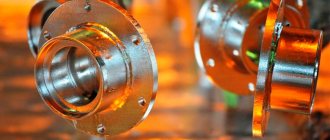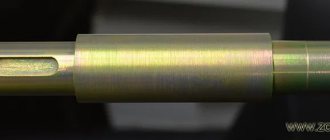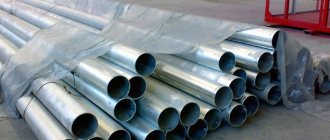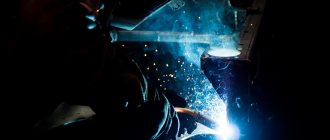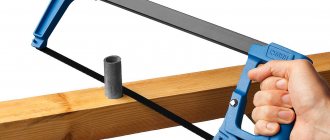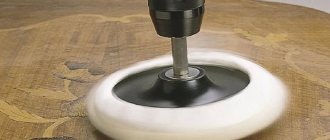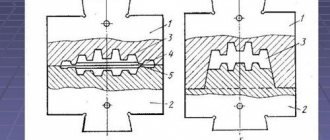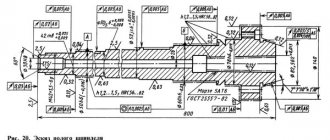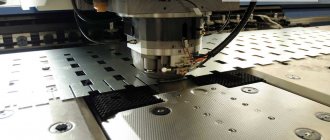What is electroplating?
Galvanics is a branch in the science of Electrochemistry that studies the processes of deposition of metal or oxide on the surface of products to give them new functional properties or improve their appearance. Simply put, electroplating is the application of a protective metal film to metal products.
How do processes occur in electroplating?
A solution (hereinafter referred to as electrolyte) is poured into a special bath and the product to be coated is placed. “Anodes” (pieces of metal that serve as a “donor” for the coating) are placed in the same solution.
A current transformer (rectifier) is attached to the anodes and the product, the anodes are connected to “+”, the product (cathode) to “-”. Electric current is supplied. The anode slowly dissolves in the solution and is then deposited on the product, thereby forming a coating.
Sometimes customers ask questions: “Can you do electroplating?” It is impossible to say only “Galvanize”, meaning by this some specific coating. More than 30 types of metals and oxides are deposited using the galvanic method, so you always need to clarify what kind of coating is required. Galvanization is a method, and, for example, galvanizing is a specific coating.
Figure 1 - Schematic diagram of an electrolyzer in electroplating.
This technology is used at our research and production enterprise Electrochemistry. We have been working in the field of electroplating for more than 7 years. We provide electroplating and chemical coating services to industrial enterprises in the electronics, aviation and mechanical engineering industries. We have experience working within the framework of the State Defense Order.
Connecting electrodes
Electrodes are connected to the bath and the product to start an electric current. The positive terminal is connected to the anodes, and the workpiece is connected to the negative terminal. After starting the galvanic system, an electric current passes through the electrolyte, so metal cations stick to the surface of the negatively charged product. The metal contained in the electrolyte settles on the part in an even, uniform layer. Two anodes are used to treat the surface on both sides simultaneously. This is a very simplified but correct diagram of the galvanic process.
Purposes of electroplating.
The main goal is to obtain the desired properties of the product. For example, corrosion protection. Imagine that in a huge factory the main engine mechanism has rusted and broken and all processes have stopped. This is millions of rubles of losses per day. It is much easier to galvanically protect all parts of the mechanism from rust and prevent this from happening.
Sometimes, instead of making a product entirely from expensive metal, it is more economical to make it from cheap metal and plate it. For example, medals for championships are made this way; they are made of brass and plated with gold, silver and bronze.
Next, we present the main metals applied in electroplating and indicate what properties they provide for the product:
Zinc (corrosion protection, improved appearance)
Tin (corrosion protection, improved electrical conductivity, improved solderability, improved screwability of threaded connections)
Nickel (corrosion protection, increased hardness, increased wear resistance, improved electrical conductivity, improved solderability, improved appearance)
Copper (used as a soft sublayer under other coatings, improving screwability, improving thermal and electrical conductivity)
Chrome (corrosion protection, increased hardness, increased wear resistance)
Silver (improved electrical conductivity, improved solderability, improved appearance)
Lead (anti-friction properties, improved solderability, protection against acids)
Cadmium (marine corrosion protection)
Oxides. (increased wear resistance, protection against corrosion). This is a separate group. Read about it in paragraph 6
This is not a complete list of metals and their properties. Read more in the catalog of articles on galvanizing in the sections “How to choose a coating?” and “Where are which coatings used?”
Discussion with the customer of the technical specifications and preparation of the electrolyte.
You can’t just start coating a product as soon as the client brings it. A technical specification (TOR) for galvanic coating is required. It is compiled based on the client's goals. What does he ultimately want to achieve? His goal is a beautiful souvenir that will lie on the shelf - choose chrome or nickel. The goal is to protect the steel product from corrosion for 20 years - we choose zinc. The goal is good electrical conductivity of the busbar in the electrical cabinet - our tin/silver/nickel option. Etc.
Here you also need to specify the thickness of the coating. The greater the thickness, the better the coating protects the product, but the price of the coating is higher.
If the Customer does not have technical specifications for galvanizing, a verbal description of what properties are required for the product is sufficient. Or under what conditions the part will work. A competent manager will select the galvanic coating himself. You can call our office for a free consultation.
Electrolyte preparation. Electroplating enterprises operate on pre-prepared standard electrolytes. The solutions are reliable, tested and suitable for most orders. But in some cases it is necessary to dilute the personal solution to achieve certain coating characteristics. Before each new order is put into operation, engineers analyze whether a standard solution is suitable or whether a personal one is needed.
Purpose of the galvanic method
Electroplating of metal on the surface is used to give them the properties of a specific material (silver, gold, nickel, etc.). Or if it is impossible to make an item from this material, and also if the price is unreasonably high.
For example, the application of chromium imparts hardness and anti-corrosion properties to plain steel. This technology was widely used to coat parts and mechanisms of machine tools. Chrome, in addition to being hard, gives a mirror-like shine and provides good protection against corrosion. Chrome is a hard but brittle metal, and it is not possible to manufacture parts and objects from it. Applying it to the surface by electroplating is a good alternative, as well as the opportunity to use the properties of chromium in everyday life.
The galvanizing process is carried out in special baths. An electrolyte containing salts of the metal that is deposited on the surface of the workpiece is poured into it. Compared to other methods, electroplating technology has advantages. When using, for example, a spray gun or other spraying devices (many organizations pass off this method of metallization as electroplating), it is impossible to achieve a perfectly even coating, high-quality adhesion and obtain the properties of metal on the surface. Usually, a non-conductive polymer layer is applied by spraying, in other words, paint, or a thin silver layer (for the reaction of a silver mirror, see the school curriculum), and on top is a transparent or colored varnish. The electroplating process makes it possible to obtain a uniform, dense, well-adhesive coating that has all the properties of the deposited metal.
Technological process in galvanization.
1) Inspection and preliminary operations
Before starting work, the product is carefully inspected for defects, washed from dirt, dust, burrs, and a thick layer of fat. If the product does not have a hole for fastening, it must be made.
2) Tie on a wire
The product is immersed in the solution on a wire. Therefore, when calculating what thickness of wire to choose and how many garters to build, it is necessary to take into account the weight of the products. Current will flow through the wire (usually copper), so the cross-section (thickness) of the wire is selected based on the current density supplied to the product.
Then, after each process, the products must be washed. This is done to avoid one solution getting into another and for a better quality coating.
3) Chemical degreasing
The next step is chemical degreasing. On any product there is a fatty film that interferes with high-quality coating. The film is removed with detergent.
4) Electrochemical degreasing
A similar operation, only here a small current is additionally supplied to the products. At the end of the process, even the thinnest fat film is removed.
5) Etching
This is the removal of oxides on the product (rust, scale, etc.). Here you need to be especially careful, because... For etching, acids (hydrochloric, sulfuric) or concentrated alkali are used. The process is necessary to obtain high-quality adhesion of the coating to the product. If we work with steel, after etching the product will begin to rust in 10-30 seconds. Therefore, it needs to be washed as quickly as possible and sent to storage. stage.
6) Electroplating
Actually the process itself. It is produced on an exceptionally clean prepared surface. The anodes dissolve and the metal is deposited on the products.
7) Additional operations (not always).
Sometimes, after electroplating has been applied, it needs to be reworked. For example, polish for shine.
 Drying
Drying
It is not recommended to use a wet product immediately. After electroplating, in the first day the applied metal is active and likes to absorb dirt, grease from fingers, etc. Therefore, it is better to let the products dry for a day at room temperature in the warehouse.
9) Electroplating control
Compliance with the customer’s technical requirements is checked by a specialist from the Technical Control Department (QCD). Measures thickness, adhesion (adhesion strength), gloss, solderability and a bunch of other parameters. If everything is in order, a quality certificate is issued for the products, and they go to the customer. If not, the products are returned to the workshop to remove the defective coating and apply a new high-quality one.
NPP Electrochemistry carries out a full cycle of work on applying galvanic coatings. After applying the coating and checking it, we issue a quality passport (certificate). This is especially important within the framework of the implementation of the State Defense Order.
Preliminary inspection of the part
Before starting work, the expert will conduct a preliminary examination, assessing the size, shape, geometry of the product, the presence of decorative elements, engraving, and relief details. The composition of the metal is also important.
Based on the information obtained, the composition of the electrolyte is selected. The exact thickness of the galvanic layer is agreed upon with the customer in advance. The thicker the coating, the longer it will last, the higher the processing costs and, therefore, the higher the cost of work.
If necessary, the metal is additionally degreased and cleaned. Polishing is only possible to a small extent and only on simple parts. If you need to get a mirror coating on a product, you need to first polish it at a jeweler or yourself. This is the only way to obtain a perfectly smooth galvanic coating. The integrity of the product is not compromised when applying galvanic coating. If the part is complex, then disassembly into individual parts is required before the galvanizing process.
Often, before the process of applying metal begins, it is necessary to carry out preliminary mechanical processing. This is necessary, since the applied metal completely preserves the structure of the surface that was before treatment. Therefore, if it is necessary to carry out a complete restoration of the surface, defects are specified in advance, we clarify what can be corrected and what will remain after treatment.
The thoroughness of mechanical surface treatment depends on the depth of defects (scratches, impacts, grinding, corrosion cavities, etc.). Mechanical processing (from coarse to fine processing):
- sandblasting;
- grinding;
- Kratsovka;
- polishing
After mechanical processing, they begin directly to apply the metal to the surface, that is, directly to electrochemistry. The technological map of the galvanic process is written depending on the source material and the finishing coating.
The sequence of actions and the time between baths are of great importance. The entire line of electroplating must be completed without long breaks.
Conversion processes (Chemical oxidation, Anodizing, chemical phosphating).
The main difference between these processes is that you do not apply a coating on top of the product, but produce it from the metal of the product itself. Roughly speaking, a protective crust forms on the surface. Therefore, after coating, the dimensions of the product practically do not increase (the protective film grows inward)
Another important difference is polarity. For conventional coatings, the product is hooked to “-”, and the anodes to “+”. Here everything is the other way around. The product will be “+” and will dissolve in the process, and the anodes should be “-”.
Chemical oxidation (Chem.ox) is used for steel or aluminum products. After coating, a very thin protective crust forms on the surface. (2-3 microns).
Anodizing (An.ox) – for aluminum. In this case, the protective crust is thicker (20-40 µm).
Phosphating (Chem. phos) – for steel products. A film of iron salts (phosphates, 20-40 µm) forms on the surface.
Figure 2 - Anodizing
Figure 3 - Chemical oxidation
Figure 4 - Chemical phosphating
The coatings are relatively low in cost. (especially Chem.ox)
Equipment. Relevant for electroplating at home.
Containers for solutions. They will contain our working electrolytes. It is better to choose seamless containers, but this is not a mandatory requirement.
Any polypropylene or polyethylene dishes, jars for spices, scraps of canisters, etc. will do. As a last resort, use new enamel pans until the enamel cracks (after which the steel base quickly corrodes, contaminating the solution, and with severe corrosion, the electrolyte may simply leak out).
Metal utensils, lavsan, PET water bottles or mineral water will NOT be suitable. We hope that more exotic materials such as clay, wood, chipboard have never crossed your mind.
SAFETY. Containers must be sealed and structurally rigid so that they do not “explode” when filled. It is better to check with plain water. To strengthen it, you can put a harness made of wood, metal, or polymer cables around the container.
Current-carrying buses. In the upper part of the container you will need to make cuts for attaching tires or thick wire taken from the wires. The buses will then be connected to the current source. If we want to deposit metal, then one busbar, on which the part will be hung, is connected to (-), the other two to (+), to the left and right of it. The anodes will be placed on them. With anodic oxidation, everything is done the other way around. The cross-section of the busbars must be selected based on the DC amperage - the higher, the thicker.
A copper bar or wire WILL WORK. Both can be found in electrical stores.
Aluminum and steel will NOT SUIT, because... They corrode very quickly and it is impossible to achieve good long-term contact with the part. An exception is electrochemical degreasing, when tires can be made of steel, but must be immersed in a solution.
SAFETY. Tires (-) and (+) must not touch each other. When biting the wire, you need to protect your eyes from small particles. To avoid accidentally short-circuiting the cathode and anode buses, their ends can be insulated with electrical tape.
Anodes (counter electrodes). When depositing metals, anodes are made either from the metal that is being deposited, or insoluble - from stainless steel, titanium, lead. When producing oxides (anodizing), the part itself plays the role of an anode and counter electrodes to it - cathodes, are made, as a rule, from lead and its alloys.
| Any plate made of the appropriate material will SUITABLE. It is better that it is larger, but does not exceed the size of the part to be coated (total area). Otherwise, there is a risk of getting “burnt marks” on the edges of the part. You can hang several counter electrodes on one busbar. A plate made of mixed different materials of unknown composition will NOT SUITABLE. SAFETY. Lead is very toxic. It should not be handled with bare hands or its dust should be inhaled during mechanical processing. Casting lead at home is a very bad idea! A sign of lead ingestion is a sweetish taste in the mouth). |
Electrolytes. A solution in which the reactions we need occur under current. Each process requires its own solution. Some components, such as copper sulfate or battery sulfuric acid, can be bought in the store, others cannot. The electrolyte is obtained after diluting the required reagents in water to the prescribed concentrations. We will look at the compositions of solutions in a separate article.
SAFETY. It is better to work with electrolytes wearing latex or nitrile gloves, always wearing glasses and under a hood. Contact of solutions on the skin is usually not fatal, but there are some that can cause burns (strongly alkaline or strongly acidic). Contact of nitric acid and chromic salts on the skin almost instantly leads to yellowing of the skin. You can store prepared electrolytes in containers similar to working containers. However, it must be hermetically sealed and kept out of the reach of children. Many solutions are colored and children may think it is soda or something tasty. ALL ELECTROLYTES ARE TOXIC TO HUMANS!!!
Electrolytes should not be poured into the sewer, as well as rinsing water after them. This is a punishable action. What to do with them is your personal responsibility!
DC source. You need a device that converts alternating current into direct current. It's called a rectifier. In addition, it lowers the voltage and increases its amperage.
A factory rectifier with smooth current regulation, voltage stabilization and ripple regulation is SUITABLE. But, as a rule, it is unreasonably expensive, in terms of the cost of 1A of current supplied. An excellent replacement is chargers for car batteries. The best solution is ORION. The most powerful of them produce up to 20A at 20V. Their applicability has been tested many times in practice.
Chargers for household appliances and telephones, welding machines (they are not designed for long-term operation under load), rectifiers without adjustment (if you do not equip them with flux chords) will NOT be suitable.
SAFETY. The rectifier is an electrical device, therefore all electrical safety standards apply to it. Do not work with it with wet hands, do not allow solutions, aerosols, or bath exhaust to come into contact with it. In the event of severe oxidation of the components inside the device, it can create a short farewell “fireworks display”.
Mixing devices. Many solutions work better if they are stirred. You can use a simple stick and your hands, but it is better to entrust this matter to “professionals”. So, aquarium compressors are perfect. The larger the volume of the aquarium for which the compressor is designed, the greater the air flow and the more intense the mixing.
An aquarium compressor with smooth adjustment will be suitable. Without adjustment, devices are less versatile and may overmix small volumes of electrolytes, causing splashing.
Any mixers that contain elements that come into contact with the solution and corrode in it will NOT SUITABLE. A mixer is probably not a very good choice, but if you try...
SAFETY. The compressor is also an electrical device, just like the rectifier. We won't repeat ourselves here. What is important is that you need to check it on the required volume of a bath filled with water. It is better to have water splashed in your face rather than a chemical solution if the compressor power is selected incorrectly.
Heaters. Some electroplating solutions work with heating up to 50-60o C. High temperatures are rarely needed. Simply putting a boiler in will not work. It will corrode and burn very quickly. In the event of an insulation breakdown and due to the high electrical conductivity of our solutions, you can additionally receive an electric shock upon contact with the working container. How to heat the solution in galvanization?
WILL SUIT. Aquarium heaters. True, there are hardly any fish that love a hot Jacuzzi at a temperature of 50 ° C. Therefore, such heaters are equipped with thermostats with a very narrow temperature range. You should not remove the thermostat yourself, because... the heater's seal is broken, and they are designed for complete immersion. And yet, if you need a temperature slightly higher than 30 ° C, then they are quite suitable.
You can use a water bath. Place the container with the solution in a pan of water and heat it up. It is important that the solution does not splash into the pan, otherwise a corrosive environment will be created in it over time.
The best option is professional chemical-resistant heaters, but they are not always available and are always expensive.
WILL NOT FIT. Household immersion heaters. For the reasons described above. And you definitely shouldn’t try to place the bathtub on a heating tile.
Hood. It does not directly affect the galvanization process, but makes it safer. The more powerful the better.
WILL SUIT. At home, you can use kitchen hoods, but keep in mind that they are not chemical resistant. The grille in them is generally made of aluminum, which quickly rots from many fumes. You can use duct fans, but you will still have to make an exhaust hood. A powerful solution for the home are MARS fans, which suck out more than 600 m3 of air per hour.
WILL NOT FIT. Floor fans, any ventilation system that can harm other people.
SAFETY. The hood cannot be vented into the general system of the house. Thanks to powerful fans, you will transfer fumes into your neighbors’ apartments. In general, if you are going to work with steaming and aerosol processes, think about it! According to the legislation of the Russian Federation, your installations will be classified as stationary sources of emissions, which entails a huge number of consequences. Responsibility always lies with you, incl. and criminal!
Galvanic process
The system is run via a constant current source with adjustable input voltage or current levels. The longer the effect of electric current on the electrolyte and the product lasts, the thicker the protective coating layer becomes. Sometimes a part is processed several times, depending on the specific technology and the final task from the client.
The temperature of the electrolyte is important. Sometimes an additional heating device is used, which is immersed in the galvanic bath or located outside it.
Strict requirements are imposed on the room where processing takes place. A prerequisite is effective ventilation, running water and fire safety. The work takes place in laboratories that are specially equipped to perform such tasks. Optimal microclimatic conditions are created here, the required temperature and air humidity are maintained. Experts work in special protective suits. The technology of metal electroplating has been thoroughly studied by representatives of the research and production enterprise.
Advantages and disadvantages of galvanization. Comparison with the hot method.
As we already know, metal can be applied to a surface in different ways. For example, the most common is the hot method. This is when the product is immersed in a huge pool of molten metal. Let's compare it with galvanizing.
Advantages of galvanizing:
1) You can set the coating thickness as accurately as possible (accuracy up to 1 micron). While the hot method has a thickness of 200-400 microns. This is especially important for high-precision products. It will be unpleasant if, due to the thick coating, your product does not fit into the assembly according to tolerances.
2) Lots of coverage. More than 40 different metals can be applied by galvanic method, no more than 10 by hot method.
3) Setting up the process. In electroplating, the solution can be adjusted to produce a coating with different properties (for example, bright or matte chrome plating).
4) Uniformity of coverage. Often, in products with a large number of internal cavities, it is impossible to achieve uniform coverage of the cavities using the hot method; sometimes the cavities are left without coating at all. In electroplating, everything is relatively uniform.
Disadvantages of electroplating:
1) Low performance. A relatively hot method that can coat hundreds of tons of products per day. Electroplating takes longer to set up.
2) High price. Based on low performance. Electroplating is always more expensive than the hot method, simply because the coating requirements are higher.
3) Requirements for technical specifications. If you want high-quality coating, describe the requirements in as much detail as possible. If you don’t know what you want, you will definitely get the wrong thing.
4) Rarely suitable for particularly large products. If the product has a large area, a huge amount of current will be required to cover it. Few enterprises in Russia have such production capacities.
Electroplating Process Stages
- chemical galvanic cleaningChemical cleaning is carried out to remove residues of polishing pastes, oils, grease from fingers, etc. The cleaning operation is carried out chemically or electrochemically. The choice of cleaning method depends mainly on the shape of the part. Simple shapes are processed under current, complex shapes with large internal cavities, holes and concave surfaces are processed chemically. The main indicator of properly carried out cleaning is complete wettability of the surface. Poor surface cleaning is the most significant error in galvanic processes.
- etchingThe etching procedure is carried out to improve adhesion to the metal surface. Etching is also carried out both chemically and electrochemically. The etching procedure is not used for mirror surfaces, since the surface class of the part after etching will be worse than it was initially. Electroplating in some cases compensates for etching, but this is the exception rather than the rule.
- application of sublayer galvanizing
Electroplating works according to strict laws and requires adherence to the application order. For example, copper and gold must be separated by a layer of nickel to avoid diffusion processes of gold into copper. In addition, these sublayers are required to increase the gloss of the surface itself, increase adhesion and increase the overall dimensions of the part.
The line of different sublayers often consists of a so-called classic galvanic cake, consisting, for example, of layers such as nickel-copper-nickel.
In many cases, this universal scheme requires adjustment and refinement.
In production, technological maps are written for each process individually, indicating operating modes, holding time and sequence of operations.
Obtaining new products requires the development of an individual technological map. This is the main difficulty of a small electroplating production - diverse products require daily work to set up the process.
Correcting errors in 90 percent of cases involves complete cleaning of poorly applied elements. Moreover, most often this has to be done mechanically; the chemical method of removal has limited use in electroplating.
- application of final galvanic coating The final application of metal is carried out only on a fully prepared, clean, non-oxidized exterior of the product. Electroplating in general and finishing coating in particular does not improve the class of mechanical processing. If, after applying all the preparatory coatings, the part does not look of high quality (not shiny, there are defects in the coating or the original surface), then there is no point in applying the finishing coating. Not taking this fact into account is one of the most common mistakes of a novice electroplater. The thickness of metal applied to the surface specified in the technical specifications (3 microns, 6 microns, 20 microns) refers specifically to the finishing coating. This is what ensures its durability. Sublayers can be of any thickness, if there are no strict requirements for them. Before applying the finishing galvanization, the product must be thoroughly washed to remove any remnants of sublayer elements (electrolytes). Washing is carried out with running hot and then cold water, and then additionally washed with distilled water. The latter is needed to prevent running water from getting into the electrolytes of precious metals, because chlorides, salts of heavy metals, and sulfates are destructive to silver and gold electrolyte. The accumulation of impurities in precious metals should not be allowed. Spoiled electrolytes are subject to long-term processing or disposal. At this stage, electroplating is completed, but additional refinement is often required.
- related operations. Sometimes the finishing coating is the last stage of the galvanic process, but often this is not the case. Example: after applying the finishing electroplating silvering, mandatory brushing of the surface is required. This is done manually, or “tumbling drums” are used. If such post-processing is provided, silver (or other metal) is applied 2-5 microns more than initially required, and possible losses are taken into account. Polishing post-processing is rarely used, since this removes a significant layer of the applied metal. That is why, to obtain a smooth surface, preliminary polishing and preparation is required before all galvanic operations.
Electroplating price.
The first thing you need to understand is that there is no single price for electroplating for all products. Why?
Here is an example: If you specify the price for the coating, say, 60 rubles per 1 kg.
1 kg can be a metal bar, which takes up almost nothing in area. Or it could be unwound wire that takes up half the room. In terms of price, both products will cost 60 rubles. Now imagine how much more difficult it is to coat a wire than a block?
There are indicative prices for standard coatings. They are used by suppliers when it is necessary to estimate the budget for a project. But electroplating enterprises will indicate the final price only when they look at the drawings of the products or the products themselves in person.
You can find prices for electroplating from NPP Electrokhimiya here. Better yet, send your request to the manager.
Galvanic method
The galvanic coating method is used in the following industries:
- Treatment of products against corrosion;
- Coating of parts and assemblies of complex machines and equipment;
- Processing of costume jewelry and jewelry;
- Ensuring solderability and wettability of the surface of parts;
- Giving antioxidant and decorative properties to the surface (mainly precious coatings).
While large industrial electroplating baths are required in the field of mechanical engineering, automotive industry, and metal structures production, compact equipment is used in the production and electroplating of jewelry and contact groups.
Jewelry companies make up the number of regular clients of our organization. The production of jewelry from precious metals and jewelry alloys periodically requires the application of a protective or decorative layer of electroplating to the surface. For example, jewelry alloys coated with a layer of real gold increase in price several times, while the cost of jewelry is relatively low. Owners of big names often take advantage of this, releasing collections of jewelry in gold or rhodium plated, despite the fact that the price of plated earrings is often comparable to the price of earrings made of pure gold.
The requirements for electrolytes and the result of processing at a jewelry factory are very high: it is necessary to maintain the class of the surface, the shade of the applied metal, and the thickness of its application. Typically, for jewelry and decorative purposes, the application thickness does not exceed 2 micrometers, so the listed requirements are feasible.
In the field of applying decorative coatings to jewelry, 6 Micron LLC cooperates with factories from the Moscow region, St. Petersburg, Kostroma, Kaliningrad region, as well as other constituent entities of the Russian Federation.
Our organization has a broad area of activity - electroplating on souvenirs, gifts, and household items. Giving a souvenir plated with gold or silver, electroplating an antique watch, restoring it on antique dishes - all these are our daily services. For example, a builder is given a gold helmet as a gift, and a hockey player is given a gold puck. The list of ideas here is limited only by human imagination. Any item can be treated with galvanic gold to get an original souvenir or memorable gift. Gilding is performed only with 999 purity gold. Electroplating is the only way to apply real gold or silver.
Also, clients turn to us in order to obtain a beautiful chemical-resistant coating for plumbing fixtures - faucets, buttons, levers, valves.
Over the past 5 years, electroplating has also often been used for gilding jewelry made from real wood leaves, flowers, and twigs. Recently, this idea has become popular and requests for such work are coming in more and more often.
The dangers of galvanization.
Galvanization is harmful. Always! If you do not ensure compliance with safety standards, you can cause a lot of problems for yourself and your neighbors. Therefore, electroplating enterprises pay special attention to treatment facilities (purify water) and ventilation (purify air).
You cannot do electroplating on an industrial scale at home, because... This is, firstly, illegal business, and secondly, a regulated activity (Rosprirodnadzor, Ministry of Internal Affairs).
Here are articles about the harmfulness of metals to the human body. Read, draw conclusions.
• General information about the health hazards of heavy metals
• Influence of copper
• Influence of tin.
• Effect of chromium (especially harmful).
• Effect of nickel nickel.
• Effect of NO3— Nitrates.
• Effect of PO43- - Phosphates and pyrophosphates.
DIY electroplating at home
In general, we do not recommend that you do electroplating yourself at home. It’s better to contact a galvanic production facility (you can also contact us :)). Save your health and nerves.
If you still decide, we have already written about the necessary equipment in paragraph 7. We strongly recommend that you engage in electroplating at home only as a hobby, when plating piece parts and for yourself.
As we write, we will post articles on applying certain metals at home:
-Copper plating
-Tin plating
-Nickel plating
-Silver plating, etc.
Galvanoplasty and electroforming.
The essence of the process is that non-metallic products (dielectrics) are coated. To do this, a conductive coating is first applied, and then the parts are galvanized.
A special case of dielectric coating is electroplating and metallization of holes in printed circuit boards. Electroplating involves obtaining thick, up to several millimeters thick coatings on finished forms. Once the coating is separated from the mold, it becomes a marketable product in itself. If the mold remains inside the finished part, the process is called electroforming.
Galvanic technologies
In electroplating, the electroplating method is widely used. In this case, the product immersed in a galvanic bath acts as a negative, that is, the coating does not grow on the working side of the product, but on the back, reverse side. A layer of metal is deposited onto a mold made of non-conductive material, most often copper. The thickness of copper can reach 2 mm; usually such a strength margin is not required and, on average, coatings up to 1 mm are grown in electroplating. After separating the matrix from the created layer, its exact copy is obtained. In this way, exact copies of salaries, medals, panels, and decorative elements are created.
Chrome plating of a car.
Another misconception is that chrome plating a car is always galvanizing. Not at all. Almost always, chrome plating a car means paint. It just looks like chrome. But it has no connection with galvanic chromium. As soon as a small pebble gets into a disk chromed in this way, the paint will immediately fly off.
Electroplated chromium has enormous hardness and wear resistance. He doesn't care about any pebble.
Speaking of price, here's an example. Plating 4 car rims with galvanic chrome will cost from 100 tr., while coating with chrome (paint) costs 5-10 tr. A tangible difference.
If a car service offers you chrome plating, check how they produce it. Most likely it will be sprayed from a hose or spray can.
In Russia, less than 10 electroplating enterprises professionally engage in chrome plating of cars and motorcycles. I repeat, it is very expensive. Restorers pay from 1 million rubles for such luxury.

